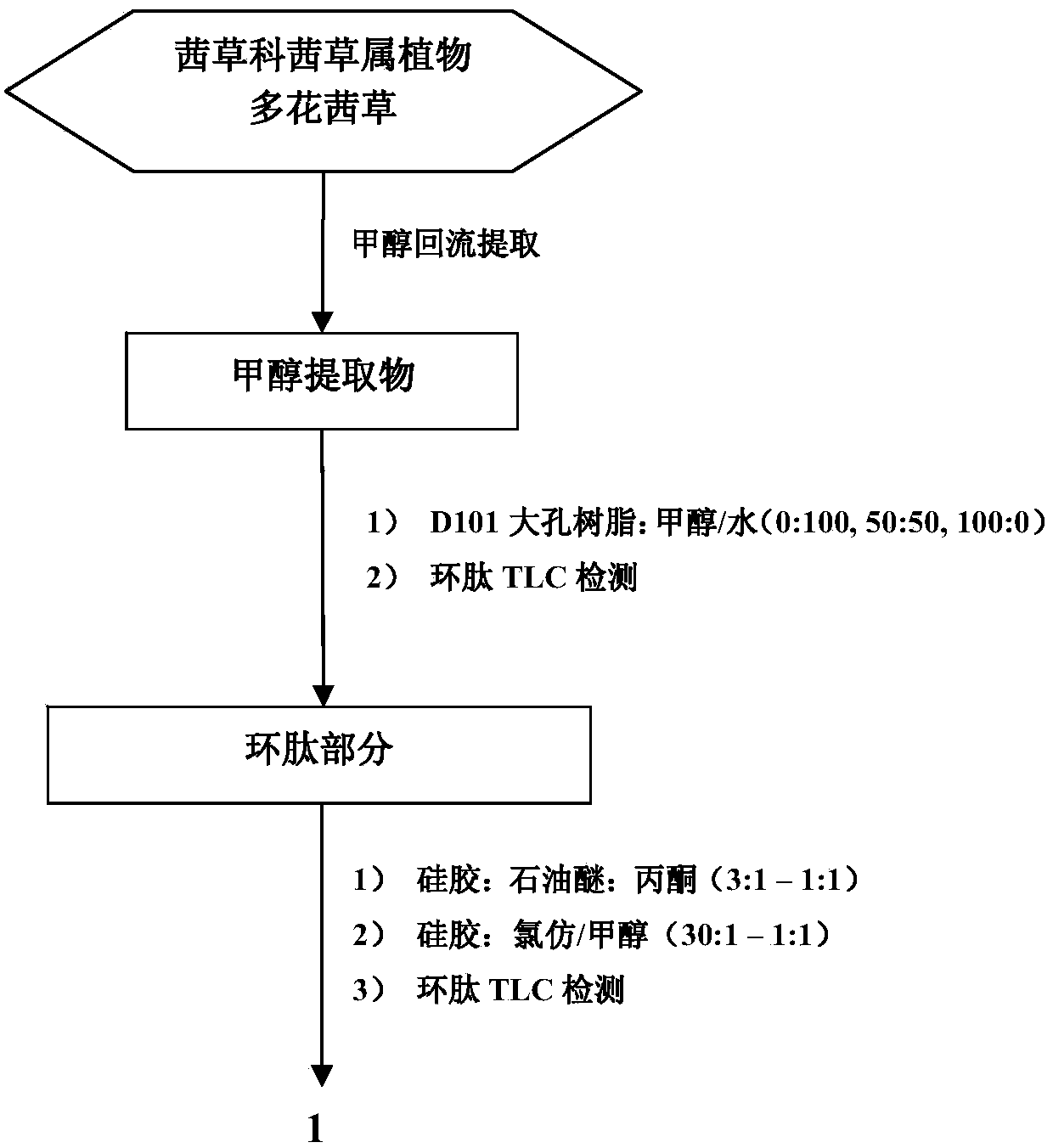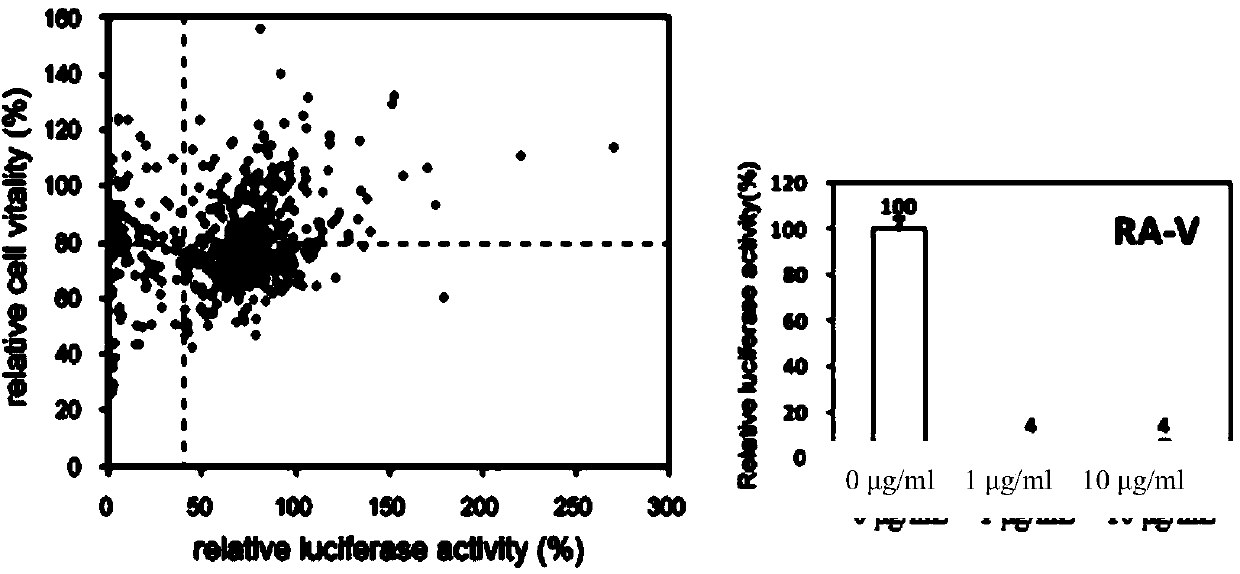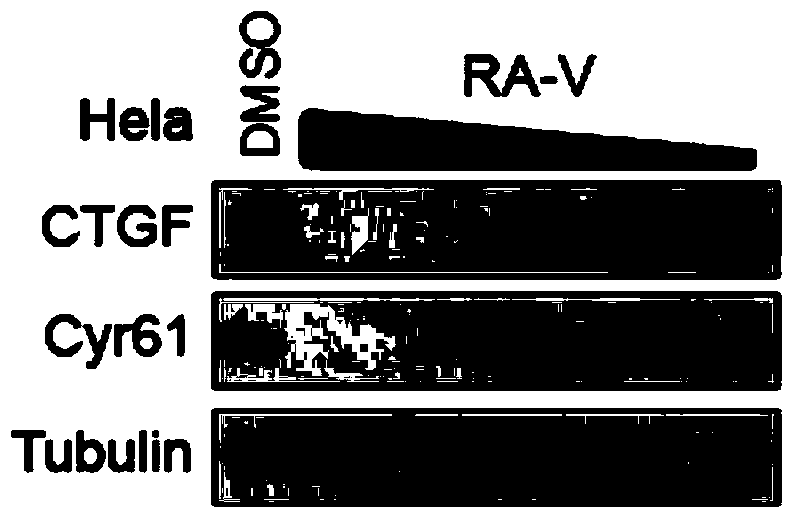Preparation method of rubiaceous cyclopeptide and application of rubiaceous cyclopeptide as Hippo-YAP signal pathway inhibitor
A signaling pathway, Rubiaceae technology, applied in the field of medicine, can solve the problems of expensive aminopropyl bonded silica materials, poor controllability and reproducibility of methanol recrystallization technology, and not commonly used
- Summary
- Abstract
- Description
- Claims
- Application Information
AI Technical Summary
Problems solved by technology
Method used
Image
Examples
Embodiment 1
[0031] The preparation method of Rubiaceae type cyclic peptide RA-V (1):
[0032] Take the roots and rhizomes (1kg) of Rubia multiflora, dry and pulverize them, and reflux extract with methanol for 3 times (3L×3 times), the time is 3h, 3h and 2h, and the extract is concentrated under reduced pressure to obtain the total extract 180g; the total extract was chromatographed on D101 macroporous resin, eluted with methanol / water gradient (100:0, 50:50, 0:100), combined with cyclic peptide TLC detection method to combine 100% methanol containing cyclic peptide The eluted part; each of the following steps must be separated and purified in combination with the cyclic peptide TLC detection method. The combined cyclic peptide fraction (11g) was chromatographed on a silica gel column, eluted with petroleum ether / acetone (3:1-1:1) gradient, and combined with the cyclic peptide RA-V (1) part to obtain the total RA-V fraction (120 mg); the total fraction of the cyclic peptide was further s...
Embodiment 2
[0036] The Rubiaceae type cyclic peptide RA-V(1) of the present invention was initially screened on HEK293 cells stably transfected with the Myc-YAP / TEAD / CTGF promoter-luciferase luciferase activity detection system, and then transiently transfected with beta galact Re-screening in HEK293 cells with the glycosidase / Flag-YAP / Gal4-TEAD4 / 9XUAS-luciferase activity detection system revealed that RA-V(1) can inhibit the activity of the Hippo-YAP pathway. The experimental principles, methods and results are as follows:
[0037] Experimental principle: luciferase reporter gene is a commonly used experimental method to detect the activity of signaling pathways. Luciferin emits fluorescence under the catalysis of luciferase, and the intensity of the detected fluorescence reflects the strength of the signaling pathway activity.
[0038] In HEK293 stable cells, the highly expressed Myc-YAP protein in the Myc-YAP / TEAD / CTGF promoter-luciferase luciferase activity detection system acts on th...
Embodiment 3
[0047] The Rubiaceae type cyclic peptide RA-V(1) of the present invention is used to detect its inhibitory activity on the expression levels of the downstream target genes CTGF and Cyr61 of the Hippo-YAP pathway in HeLa cells by Western blot technique. The experimental principles, methods and results are as follows:
[0048]Experimental principle: Western blotting, also known as immunoblotting, is an immunochemical technique that can detect proteins immobilized on a solid-phase carrier. Western blotting uses polyacrylamide gel electrophoresis, the detected object is protein, the "probe" is an antibody, and the "color development" is labeled with a secondary antibody. SDS is an anionic surfactant that is a detergent, it can break the intramolecular and intermolecular hydrogen bonds, destroy the secondary and tertiary structure of the protein molecule, and combine with the hydrophobic part of the protein to destroy its folding structure , so that the proteins can be separated i...
PUM
 Login to View More
Login to View More Abstract
Description
Claims
Application Information
 Login to View More
Login to View More - R&D Engineer
- R&D Manager
- IP Professional
- Industry Leading Data Capabilities
- Powerful AI technology
- Patent DNA Extraction
Browse by: Latest US Patents, China's latest patents, Technical Efficacy Thesaurus, Application Domain, Technology Topic, Popular Technical Reports.
© 2024 PatSnap. All rights reserved.Legal|Privacy policy|Modern Slavery Act Transparency Statement|Sitemap|About US| Contact US: help@patsnap.com










